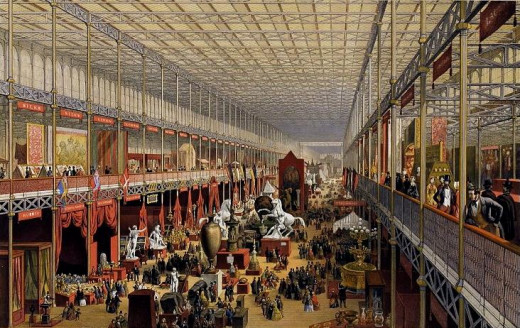- HubPages»
- Education and Science»
- History & Archaeology»
- History of the Modern Era
The Great Exhibition at Hyde Park, London

If you had been in London's Hyde Park during the summer of 1851, you would have seen something truly magnificent. A gigantic palace of glass which contained all the latest in industrial technology that Britain and the world had to offer at the time.
The Great Exhibition of the Works of Industry of all Nations was a celebration of industrial technology and design. It was organized by Henry Cole, Francis Henry, George Wallis, Charles Dilke and other members of the Royal Society for the Encouragement of Manufactures, Commerce and Arts. Prince Albert, the husband of Queen Victoria, was president of the organisation and he did a great deal to encourage interest and finance the exhibition.
Queen Victoria opened the exhibition on May 1st in 1851. She visited again many times until the exhibition closed five and half months later on 11th of October. There were exhibits from all over the world, but over half of the display space was taken up by British exhibits. Britain clearly saw the exhibition as an opportunity to display their superiority over other nations.
The exhibition drew enormous crowds. Among the thousands who visited were a number of notable people of the day, including Charles Darwin and Charles Dickens and Charlotte Bronte.
Of the exhibition, Bronte said: “Its grandeur does not consist in one thing, but in the unique assemblage of all things. Whatever human industry has created you find there. It seems as if only magic could have gathered this mass of wealth from all the ends of the earth.”

What Was The Crystal Palace?
Built in Hyde Park, the structure which was created for The Great Exhibition was called The Crystal Palace. It was designed by Joseph Paxton. Noted engineer Isambard Kingdom Brunel was one of the committee members who oversaw the construction of the building.
The first pre-fabricated building of its kind, The Crystal Palace was a glass house with iron-frame components. It was an impressive building and the largest in London at the time. Inside, there were trees and statues. In the middle, there was a 27 feet high fountain which was made of pink glass.
The building was later moved to another venue in South London. The area it was moved to was renamed Crystal Palace. Unfortunately, the building was later destroyed by fire on 30 November 1936. The foundations of original The Crystal Palace can still be found in Hyde Park.

What was Exhibited at the Great Exhibition of 1851?
There were 13,000 exhibits at the Great Exhibition in London. The wide range of attractions were largely connected to new developments in technology. They included:
- A massive hydraulic press, which had lifted the tubes of a bridge.
- Carpets from Axminster and ribbons from Coventry.
- A prototype of an 1851 Colt Navy from firearms manufacturer Samuel Colt.
- The world's biggest diamond, the Koh-i-Noor.
- The Tara Brooch, an Irish brooch, which had been made in 700AD.
- An early version of the first fax machine, from Frederick Bakewell.
- A carriage drawn by kites and furniture made of coal.
- A set of artificial which were made with a swivel device so that the user to yawn without them coming out of place.
- A printing machine which produced 5000 copies of Illustrated London News in an hour.
- Fire engines from Canada, which had panels painted with Canadian scenes.
- Hiram Power's statue of a Greek slave in white marble.
- Tapestries, porcelain and silk from France.
- Sets of stuffed animals from Germany, which were placed in a variety of poses, including a scene of kittens taking tea.
- The first public toilets, designed by sanitary engineer and plumber George Jennings.
How Many People Visited The Great Exhibition?
The Great Exhibition of 1851 was hugely popular. There were six million people entries to the exhibition.
Admission prices varied. At first the price of entry was £3 for gentlemen and £2 for ladies. From the 24th of May, the masses were let in at a price of a shilling a head.
All kinds of people attended. The railway enabled people to travel to the exhibition from way out of London. Many people who had never visited the city before made their first trip to the capital city. These included factory workers, country villagers and school children.
One mysterious Chinese man was seen in robes as the royal procession passed by. He was treated as a visiting dignitary, but it turned out he was just the Captain of a Chinese junk which was moored on the River Thames.
By the time it closed, the exhibition had made £186,000. The money raised was later used to found the Victoria and Albert Museum, the Science Museum and the Natural History Museum.
The popularity of the exhibition wasn't appreciated by everyone though. In fact, some people were concerned that the mass crowds might turn into an angry, revolutionary mob.
A special division of the newly formed Police force was created to keep the event crime free.
What Effect Did The Great Exhibition Have on Britain?
The Great Exhibition had a major impact on many aspects of society in Britain, including education of the arts, trade relations and tourism. Above all, it encouraged a passion for industrialization.
The event encouraged the people of Britain to welcome industrialisation. Many had previously resisted the move towards industrialisation which was taking place in the country. The Great Exhibition encouraged them to embrace it.
The Great Exhibition of 1851 was an expression of how human effort could improve human life. It was the beginning of a new, modern Britain.





